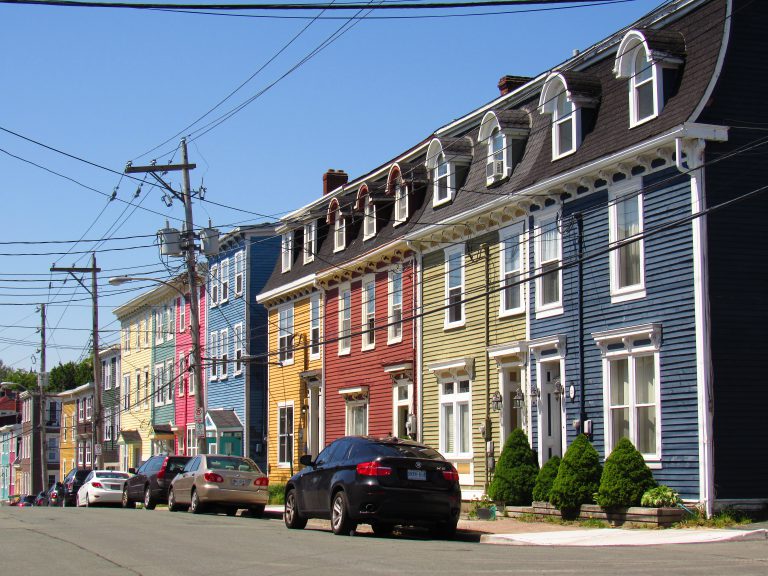Gower Street, St. John’s, Newfoundland. More photos.
By Elliott Brack, editor and publisher | There are several reasons for you to visit Canada these days. We just returned from a nice trip to St. John’s, Newfoundland. Here are reasons to go to Canada now.
 First, it’s cool. We left 95 degrees in Georgia, flew to Toronto, had a two-hour layover and arrived after nine hours’ travel in St. John’s to 50 degree weather. During the entire 10 days there, it never got beyond 72 degrees.
First, it’s cool. We left 95 degrees in Georgia, flew to Toronto, had a two-hour layover and arrived after nine hours’ travel in St. John’s to 50 degree weather. During the entire 10 days there, it never got beyond 72 degrees.
It’s economical. For every American dollar you get 1.3 Canadian dollars. That’s a continuing bargain.
It’s friendly. The Canadians like Americans, and share with us many views, including the surprising Trump accomplishments. They gladly welcome U.S. tourists.
Another reason to visit: the electricity is the same as in the USA, 110 volts, which means you can attach American plugs and not have to worry about frying your device, or fool with transformers.
Grocery shopping is a pleasure in well-maintained supermarkets. (Some have indoor parking.) We even found they stocked Vidalia onions in St. John’s!
It’s historic, the oldest city in North America. St. John’s, Newfoundland, was visited by the Italian explorer Giovanni Caboto (who we know as John Cabot) in 1497. By 1527, a British sailor reported finding Norman, Breton and Portuguese ships in its spacious harbor at St. John’s. That pales in comparison to the founding of St. Augustine, Fla. in 1565.
 St. John’s is the most eastern of North American cities, closer to Europe than any other city on this continent. It’s only 1,957 miles from St. Johns to Ireland. We visited gusty Cape Spear, the most eastern part of Newfoundland, about 15 miles from St. John’s. It’s a beautiful area, with its lighthouse and open areas. While there, we got a glimpse of whales feasting on the small capelin fish, which appear annually in July.
St. John’s is the most eastern of North American cities, closer to Europe than any other city on this continent. It’s only 1,957 miles from St. Johns to Ireland. We visited gusty Cape Spear, the most eastern part of Newfoundland, about 15 miles from St. John’s. It’s a beautiful area, with its lighthouse and open areas. While there, we got a glimpse of whales feasting on the small capelin fish, which appear annually in July.
Icebergs: Though we were a little late (June is a better time), we still glimpsed three icebergs in the Atlantic off the coast north of St. John’s. The area between Greenland and Newfoundland and Labrador has the highest concentration of icebergs in the world. And it was off the Grand Banks, just southeast of St. John’s, where the Titanic was sunk. The Johnson Geo Centre, a terrific science museum in St. John’s, which we visited, has a captivating exhibit on the sinking of the Titanic. It is the clearest and most comprehensive exhibit of this disaster we’ve ever seen. It’s a must-see for anyone visiting in the area.
The Geo Center is on Signal Hill. The hill gets the name from where the first transatlantic wireless transmission from Cornwell, in the United Kingdom, to Newfoundland took place with Guglielmo Marconi in 1901. Today it’s featured as a historic site.
The entrance to the St. John’s harbor is entered through the Narrows, about a half mile wide, though deep enough for ocean liners to navigate to their downtown dockings. You also see giant icebreakers routinely in the harbor, which continually service the oil rigs in the North Atlantic about 200 miles away.
Though fishing has historically been the major money-maker in St. John’s, it still has its role, though petroleum drives the lions’ share of the economy these days. Newfoundland, three times the size of Georgia, is mainly rocky from ancient glaciers, with only 3 percent of arable land and little agriculture.
Why did we go to Newfoundland? We’d never been. It’s a great spot for Americans to visit, especially during the Dog Days of summer.
- Check out several photos by Andy Brack from Newfoundland here at a sister publication, Charleston Currents.










Follow Us